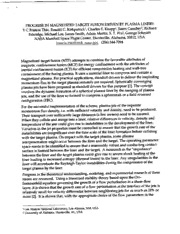Table Of ContentPROGRESS IN MAGNETIZED TARGET FUSION DRIVEN BY PLASMA LINERS
Y C Francis Thio, Ronald C. Kirkpatrick 1, Charles E. Knapp l, Jason Cassibry 2, Richard
Eskridge, Michael Lee, James Smith, Adam Martin, S. T. Wu 2, George Schmidt
NASA Marshall Space Hight Center, Huntsville, Alabama, 35812, USA
[email protected] (256) 544-7094
Magnetized target fusion (MTF) attempts to combine the favorable attributes of
magnetic confinement fusion (MCF) for energy confinement with the attributes of
inertial confinement fusion (ICI_ for efficient compression heating and wall-free
containment of the fusing plasma. It uses a material liner to compress and contain a
magnetized plasma. For practical applications, standoff drivers to deliver the imploding
momentum flux to the target plasma remotely are required. Spherically converging
plasma jets have been proposed as standoff drivers for this purpose [1]. The concept
involves the dynamic formation of a spherical plasma liner by the merging of plasma
jets, and the use of the liner so formed to compress a spheromak or a field reversed
configuration (FRC).
For the successful implementation of the scheme, plasma jets of the requisite
momentum flux density, i.e. with sufficient velocity and density, need to be produced.
Their transport over sufficiently large distances (a few meters) need to be assured.
When they collide and merge into a liner, relative differences in velocity, density and
temperature of the jets could give rise to instabilities in the development of the liner.
Variation in the jet properties must be controlled to ensure that the growth rate of the
instatbilities are insignificant over the time scale of the liner formation before colliding
with the target plasma. On impact with the target plasma, some plasma
interpenetration might occur between the liner and the target. The operating parameter
space needs to be identified to ensure that a reasonably robust and conducting contact
surface is formed between the liner and the target. A mismatch in the "impedance"
between the liner and the target plasma could give rise to severe shock heating of the
liner leading to increased entropy (thermal losses) in the liner. Any irregularities in the
liner will accentuate the Rayleigh-Taylor instabilities during the compression of the
target plasma by the liner.
Progress in the theoretical understanding, modeling, and experimental research of these
issues are reviewed. Using a linearized stability theory based upon the Orr-
Sommerfeld equation governing the growth of a flow perturbation in a shear-flow
layer, it is shown that the growth rate of a flow perturbation at the interface of the jets is
relatively small for velocity differential between neighboring jets for as much as 20% or
more [2]. It is shown that, with the appropriate choice of the flow parameters in the
1Los Alamos National Laboratory, Los Alamos, NM, USA
2University of Alabama, Huntsville, AL, USA.
liner and the target, the impact between the liner and the target plasma can be made to
be shockless in the liner or to generate at most a very weak shock in the liner. At the
same time, an extremely strong shock propagates through the target, producing the
required preliminary heating of the target, thus setting the target at an initially high
temperature (of afew 100's eV) on an efficient adiabat for subsequent compression. The
first converging and reflected shocks are analysed using Richtmyer-Lazarus theory for
spherically converging shocks. With the target temperature significantly raised by these
first two shocks, subsequent shocks are relatively weak, and the compression is nearly
acoustic. The acoustic phase of the compression has been modeled using Braginskfi's
transport coefficients for a magnetized plasma, allowance being made for losses due to
bremstrahlung and synchrotron radiation, and assuming ideal flux freezing in the
target plasma. With the appropriate choice of operating parameters, the thermal losses
are found to be relatively small. To check the overall flow dynamics, 3-D simulations of
the merging of the jets and the compression of a target plasma are performed with the
Los Alamos SPHINX code which uses a numerical scheme based upon the smoothed
particle hydrodynamics (SPH) method [3]. The detailed analysis and modeling of the
implosion of a spheromak or an FRC by the plasma liner and of the Rayleigh-Taylor
instabilities associated with this implosion remains to be done. Pilot experiments to
study the interaction of the jets to form a 2-D cylindrical liner by the merging of 12
plasma jets launched by a circular ring of plasma guns are underway.
[1] Y. C. F. Thio, E. PanareUa, IL C. KirkpatricL C. E. Knapp, F. Wysocki, "Magnetized Target Fusion in a
Spheroidal Goamgtry with Standoff Drivers," Current Trends inInternational Fusion Research II, etLE.
Panamlla,NationalResearchCouncilCanada,Ottawa,Canada,1999.
[21 J.T. Cassibry, S. T. Wu, Y. C. F. Thio, R. Eskridge, J.W. Smith, M. Lee, C. Dobson, D. Davenport, G. K
Schmidt, "An estimation of tolerances on relative velocities of spherically converging plasma jets," AIAA
Paper 2000-2267, 31'tAIAA Plasmadynamies and Lasers Conference, Denver, Colorado, June 2000
[3] C. E. Knapp, Y C Francis Thio, "Computational Modeling of the Dynamic Formation of Plasma Liner by the
Merging of Plasma Jets" Current Trends in Interna_onal Fusion Research IIL e6 E. Panarclla, National
Research Council Canada, Ottawa, Canada, 2001.

